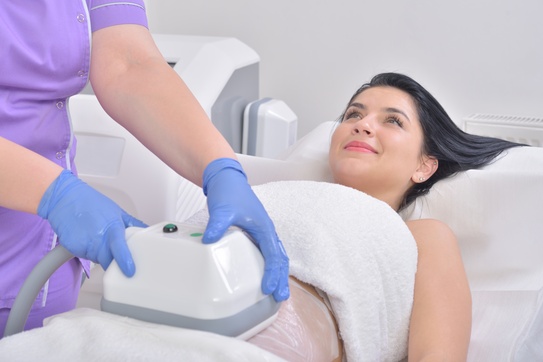Cold Truths: Indications & Contraindications of Cryotherapy in Trauma Remodeling Sessions

ABSTRACT
The integration of cryotherapy devices in post-surgical treatments within the body altering aesthetics industry has witnessed increased utilization, yet guidelines and specific indications for their use remain scarce. Cryo devices, leveraging controlled cold temperatures, manage pain, reduce inflammation, induce controlled trauma for adipose tissue reduction, and facilitate recovery following cosmetic surgical procedures. This article explores macro and micro-level indications for these devices, emphasizing their multifaceted role in minimizing tissue damage, enhancing healing, and managing pain. Recent advancements in cryotherapy technologies, offering adjustable settings and precise delivery systems, have heightened their efficacy. However, existing evidence lacks comprehensive guidelines due to methodological limitations, signaling the imperative for high-quality trials. Moreover, the article highlights cryotherapy’s potential in combating obesity but emphasizes the need for further research. Additionally, an array of cold therapy devices utilized in postoperative massage treatments and nonsurgical body contouring is detailed. The Body Altering Aesthetics Industry’s autonomous classifications for cryo devices underscore the industry’s commitment to specialized proficiency while maintaining safety standards.
Introduction:
In recent years, cryotherapy devices have gained prominence in the body altering aesthetics industry as adjunctive tools in post-surgical treatments. However the inclusion of these devices oftentimes didn’t come with manuals, directives, or even indications of when to use them and why. These devices utilize controlled cold temperatures to manage pain, reduce inflammation, introduce controlled levels of trauma to spot reduce adipose tissue, and aid in the recovery process following cosmetic surgical procedures. Both on a macro and micro level, these cryo devices offer a range of benefits, from minimizing tissue damage to enhancing healing outcomes in patients undergoing body-altering treatments and procedures. And while there are discussions going around regulated healthcare fields, most of these discussions are void of the science that identifies device indications.
Macro-Level Indications:
At the macro level, cryotherapy devices have multifaceted indications in post-surgical treatments within the body altering aesthetics industry. These devices are extensively used to reduce postoperative swelling and inflammation, particularly after liposuction, abdominoplasty, breast augmentation, and other body contouring surgeries. By constricting blood vessels and decreasing tissue metabolism, cryotherapy aids in minimizing edema and bruising, thereby accelerating the overall recovery process. Moreover, these devices play a pivotal role in managing pain perception, offering patients a non-invasive, drug-free alternative for pain relief following surgical interventions.
Micro-Level Indications:
On a micro level, the application of cryotherapy devices involves targeted and localized treatment approaches. Cryo devices provide precise cooling to specific treatment areas, allowing for controlled therapeutic effects. For instance, in microsurgical procedures such as facelifts or rhinoplasties, cryotherapy assists in reducing post-operative swelling and promoting tissue healing by restricting blood flow to the treated area. Additionally, these devices aid in the preservation of delicate tissues by minimizing cellular damage and metabolic activity, thus contributing to improved aesthetic outcomes and patient satisfaction.
Clinical Efficacy and Advancements:
Recent advancements in cryotherapy devices have enhanced their efficacy in post-surgical care within the body altering aesthetics realm. Advanced cooling technologies, such as adjustable temperature settings and precise delivery systems, enable tailored treatment approaches based on individual patient needs. Cryo devices with integrated monitoring systems ensure optimal temperature control, minimizing the risk of tissue damage while maximizing therapeutic benefits. Furthermore, the development of portable and wearable cryo devices allows for continuous and convenient post-operative care, enabling patients to experience the benefits of cryotherapy throughout their recovery journey.
Literary Review:
Based on “Does Cryotherapy Improve Outcomes With Soft Tissue Injury?” a study conducted by Tricia J. Hubbard and Craig R. Denegar, it concludes that cryotherapy is effective in decreasing pain in soft tissue. In another retrospective study of individuals presenting for cryotherapy to the Clinic BioEsthetic, Paris, France, they recorded waist circumference, body weight, and body mass index (BMI) by direct measurement and by whole-body dual-energy X-ray absorptiometric scanning. In select individuals, blood analysis of markers of inflammation and fat mobilization was performed before and after the procedure. Results. They reported that in single sessions of tissue cryotherapy lead to significant loss of tissue volume in just a few hours time frame and multiple nonconsecutive daily procedures lead to a cumulative decline in adipose tissue, as assessed by waist circumference, body weight, and BMI, confirmed by whole-body dual-energy X-ray absorptiometric scanning. The calculations of heat extracted and of compensatory weight loss taking place through thermogenesis are substantially consistent with the observed loss of adipose tissue. These findings positively argue that cold-induced thermogenesis (“cryothermogenesis”) underlies the reduction in adipose tissue volume, yielding that more intensive cryotherapy is a viable option for combating obesity.
Types of Cold Devices
In the body altering aesthetics industry, various cold therapy devices are used for postoperative massage treatments and nonsurgical body contouring. Some of these devices include:
- Cryotherapy Machines: These machines use controlled cooling to target and freeze fat cells, aiding in nonsurgical body contouring.
- Cryolipolysis Applicators: These applicators use controlled cooling to reduce fat in specific areas, such as the abdomen, thighs, or flanks, without damaging surrounding tissues.
- Cold Massage Rollers: These handheld tools contain a cooling gel or material and are rolled over the skin to reduce inflammation, promote circulation, and provide relief after surgeries or body contouring treatments.
- Cryogenic Lipolysis Devices: These devices use extremely low temperatures to induce adipocyte apoptosis (fat cell death), assisting in body contouring.
- Cold/Freeze Gel Packs: These packs are applied to the treated area to reduce swelling and inflammation post-surgery or post-treatment.
- Cold Therapy Compression Wraps: These wraps combine compression with cold therapy to manage postoperative pain and swelling effectively.
- Cryomassage/CryoContouring Tools: These handheld devices or tools have a freezing or cooling component that is used in massage techniques for reducing inflammation and pain.
- Cryosticks or Cryo Tools: These are smaller, handheld tools that offer localized cooling for specific areas, aiding in reducing swelling and discomfort.
- Cryogenic Stones: These stones are typically made of materials that retain cold temperatures well and are used in massage therapy for their cooling effect to reduce inflammation and promote healing.
- Cooling Gels and Lotions: Topical gels or lotions containing cooling agents like menthol, arnica, or camphor are applied during massages or post-treatments for their cooling and soothing effects.
- Cryomasks or Cooling Facial Masks: These masks are used for facial treatments, employing cooling technology to reduce puffiness, redness, and swelling after procedures or as part of facial treatments.
- Cold Press Devices: These devices offer localized or all-over cooling by utilizing pressurized cold air or cooling mechanisms for post-treatment relief.
Conclusion:
In the body altering aesthetics industry, the utilization of cryotherapy devices has evolved as an integral component of post-surgical treatment strategies. The Body Altering Aesthetics Industry operates with classifications for providers that are independent of external regulatory boards, distinguishing its practitioners based on industry-specific criteria. Unlike regulated industries that often have limitations on the application of certain tools by providers, the Body Altering Aesthetics Industry has developed its own standards and classifications.
Within this industry, cryotherapy devices are categorized as C10 technologies according to the classifications set by the CSL Therapy Organization. These designations establish a framework for understanding the use, capabilities, and training required for practitioners working with cryo devices. This internal classification system allows practitioners to operate autonomously within the industry, emphasizing specialized expertise and proficiency in using these technologies for body alteration and aesthetic treatments.
The delineation of C10 technologies reflects the industry’s commitment to defining and regulating specific tools and treatments, ensuring that practitioners possess the necessary expertise and training to employ these technologies effectively and safely. This autonomy in classification helps maintain industry standards while fostering innovation and advancements in body altering aesthetics treatments
These devices offer a dual-level approach, addressing macroscopic concerns such as swelling and pain management, while also providing micro-level targeted therapy for precise tissue healing and preservation. As advancements continue to refine these devices, the integration of cryotherapy in post-surgical care is poised to further optimize patient outcomes, contributing to enhanced recovery experiences and improved aesthetic results.
References
1. Bleakley C, McDonough S, MacAuley D. The use of ice in the treatment of acute soft-tissue injury: a systematic review of randomized controlled trials. Am J Sport Med. 2004;32:251–261.
2. Hocutt JE, Jr, Jaffe R, Rylander CR, Beebe JK. Cryotherapy in ankle sprains. Am J Sport Med. 1982;10:316–319.
3. Basur RL, Shephard E, Mouzas GL. A cooling method in the treatment of ankle sprains. Practitioner. 1976;216:708–711.
4. Wilkerson GB, Horn-Kingery HM. Treatment of the inversion ankle sprain: comparison of different modes of compression and cryotherapy. J Orthop Sports Phys Ther. 1993;17:240–246.
5. Laba E, Roestenburg M. Clinical evaluation of ice therapy for acute ankle sprain injuries. NZ J Physiother. 1989;17:7–9.
6. Hubbard TJ, Aronson SL, Denegar CR. Does cryotherapy hasten return to participation? A systematic review. J Athl Train. 2004;39:88–94.
7. Hubbard TJ, Denegar CR. Does Cryotherapy Improve Outcomes With Soft Tissue Injury? J Athl Train. 2004 Sep;39(3):278-279. PMID: 15496998; PMCID: PMC522152.
8. Maher CG, Sherrington C, Herbert RD, Moseley AM, Elkins M. Reliability of the PEDro scale for rating quality of randomized controlled trials. Phys Ther. 2003;83:713–721.
9. Suvaddhana Loap, Richard Lathe, “Mechanism Underlying Tissue Cryotherapy to Combat Obesity/Overweight: Triggering Thermogenesis”, Journal of Obesity, vol. 2018, Article ID 5789647, 10 pages, 2018. https://doi.org/10.1155/2018/5789647
